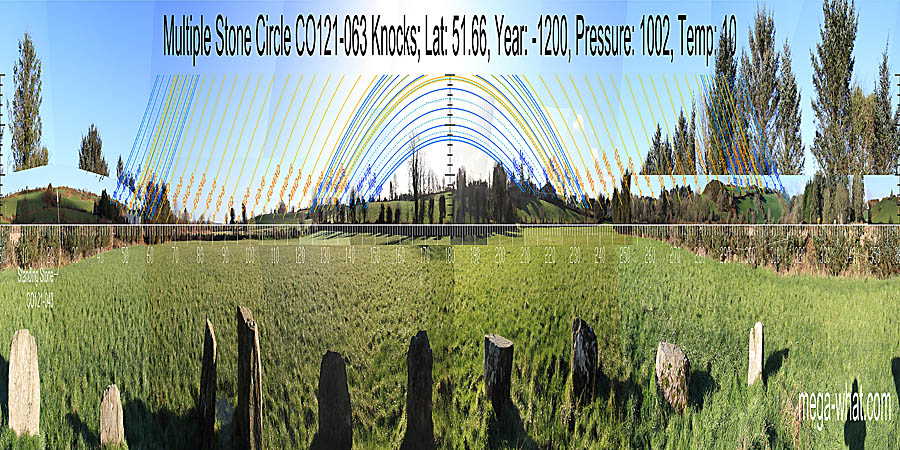 There are two multiple stone circles in the townland of Knocks in West Cork and this is the more northerly one.
Located just west of the R599 between Dunmanway and Clonakilty, about 2km south of Ballingurteen.
Ten stones of an eleven stone circle are set in a flat valley bottom but views from it are now considerably circumscribed by trees and buildings.
There are two multiple stone circles in the townland of Knocks in West Cork and this is the more northerly one.
Located just west of the R599 between Dunmanway and Clonakilty, about 2km south of Ballingurteen.
Ten stones of an eleven stone circle are set in a flat valley bottom but views from it are now considerably circumscribed by trees and buildings.
There is an approximate symmetry around the southern hill. South is on the hilltop [Pic].
North is in a dip on the western side of a hill [Pic].
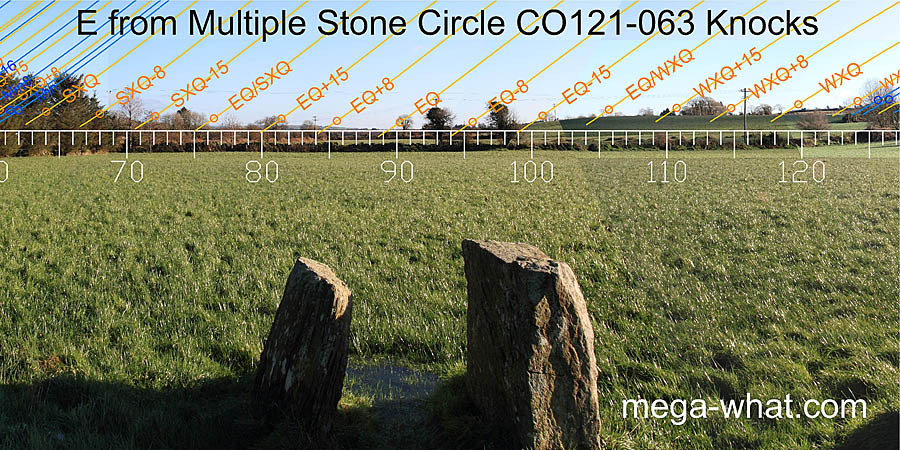 The circle's main axis is equinoctial, with the axial to portal line indicating an easterly dip between the slopes of the north and south horizons.
However the axis of the portal stones themselves points more to the NE/SW and the height ordering of the sidestones is anomalous so that there are other possible axes
[Pics].
The circle's main axis is equinoctial, with the axial to portal line indicating an easterly dip between the slopes of the north and south horizons.
However the axis of the portal stones themselves points more to the NE/SW and the height ordering of the sidestones is anomalous so that there are other possible axes
[Pics].
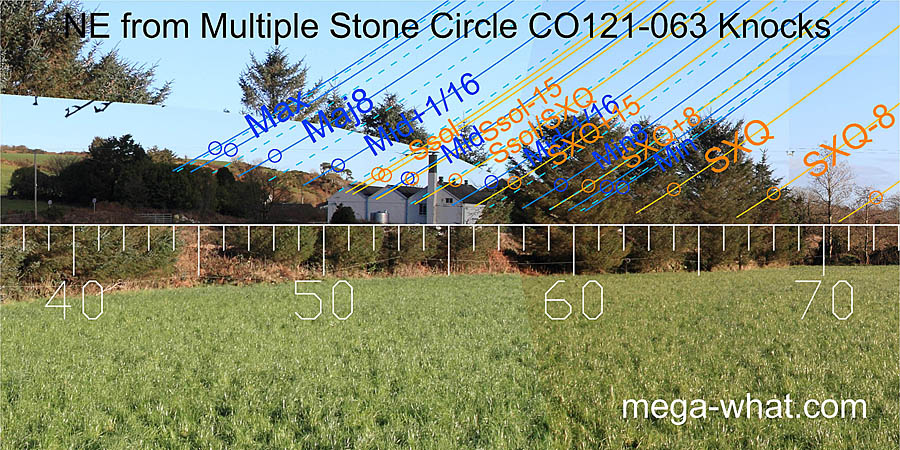 Most of the North-eastern horizon is obscured but it rises steadily from the equinoctial dip and the lunar maximum is at the top of this first section of slope.
Most of the North-eastern horizon is obscured but it rises steadily from the equinoctial dip and the lunar maximum is at the top of this first section of slope.
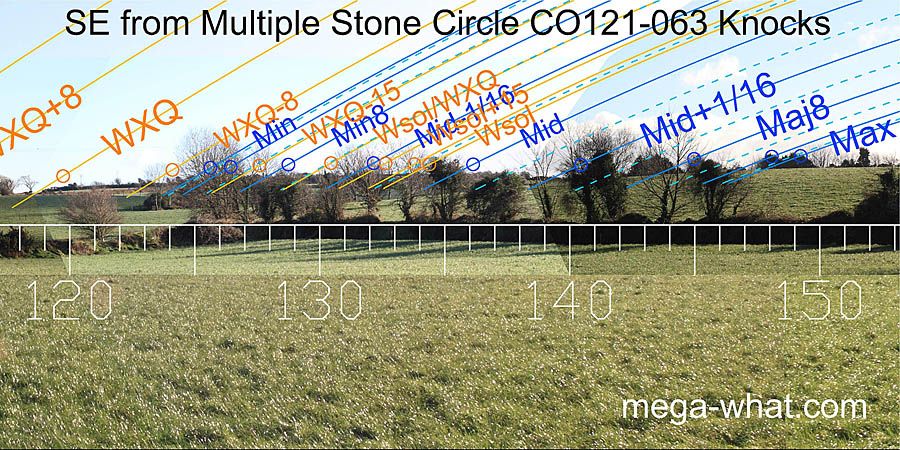 On the south-eastern slope is a low but wide hump. The cross-quarter is at its north basal step and a lunar sixteenth is at the south one. Winter solstice sunrise is on the highest part.
On the south-eastern slope is a low but wide hump. The cross-quarter is at its north basal step and a lunar sixteenth is at the south one. Winter solstice sunrise is on the highest part.
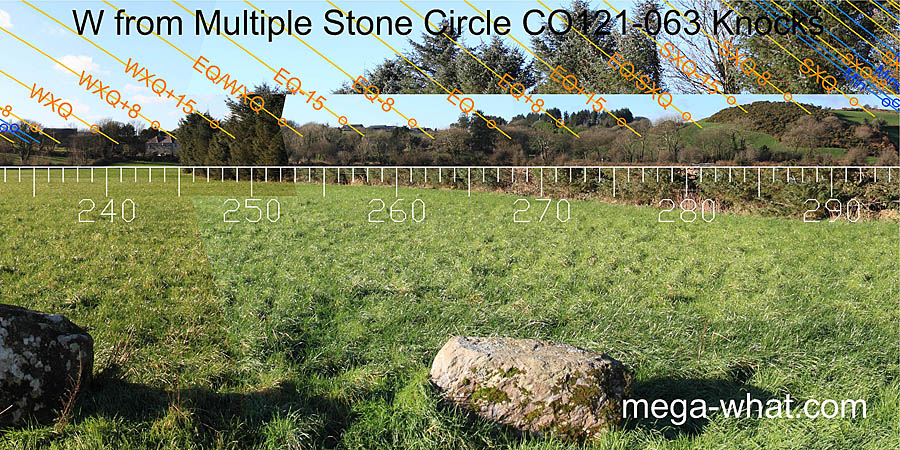 The western axis again indicates the equinoctial zone in a dip but trees obscure the detail. winter cross-quarters are also in a dip but summer cross-quarters are on a hilltop.
The western axis again indicates the equinoctial zone in a dip but trees obscure the detail. winter cross-quarters are also in a dip but summer cross-quarters are on a hilltop.
 The south-western horizon is rises steadily from the cross-quarter towards the lunar major
standstillLunistice positions vary cyclically over an 18.6 year period but are fairly static for more than a year at either end of the range,
which may have been in a bit of a dip, but buildings and trees again obscure the detail.
The south-western horizon is rises steadily from the cross-quarter towards the lunar major
standstillLunistice positions vary cyclically over an 18.6 year period but are fairly static for more than a year at either end of the range,
which may have been in a bit of a dip, but buildings and trees again obscure the detail.
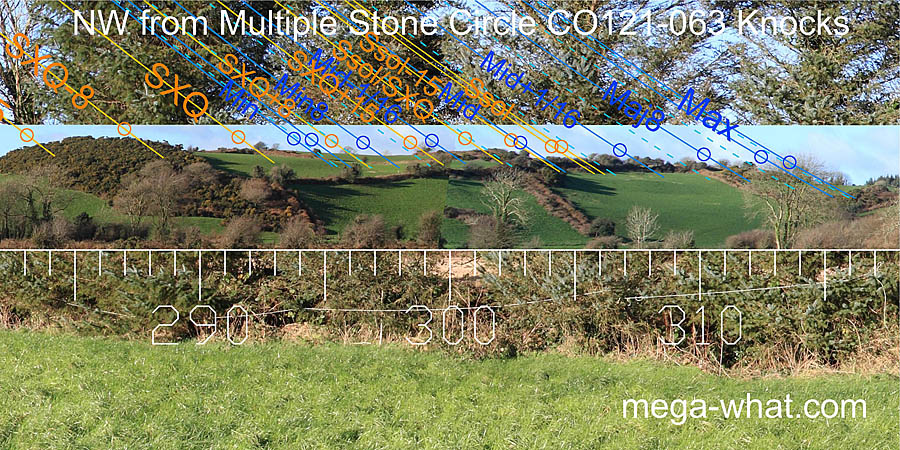 The north-western range runs down an undulating slope, from a high point that is about a week south of the cross-quarter to a dip that marks the lunar major standstillLunistice positions vary cyclically over an 18.6 year period but are fairly static for more than a year at either end of the range.
The north-western range runs down an undulating slope, from a high point that is about a week south of the cross-quarter to a dip that marks the lunar major standstillLunistice positions vary cyclically over an 18.6 year period but are fairly static for more than a year at either end of the range.
- The other Stone Circle in this townland is 1.4km south (167°)
- Lettergorman Five Stone Circle is 3.7km west (268°)
- Garryglass Multiple Stone Circle is 7.7km west (266°)
References
- Archaeological Survey of Ireland, record details. www.archaeology.ie/archaeological-survey-ireland
- BARBER, JOHN 1973 The Orientation of the recumbent-stone circles of the South-West of Ireland. Journal of the Kerry Historical and Archaeological Society 6:26-39, no.C21.
- Ó'NUALLÁIN, SEÁN 1975 The Stone Circle Complex of Cork and Kerry. Journal of the Royal Society of Antiquaries of Ireland 105:83-131, no.36.
- Ó'NUALLÁIN, SEÁN 1984 A Survey of Stone Circles in Cork and Kerry. Proceedings of the Royal Irish Academy 84c:1-77, p20, no.28.
- POWER, D. et al. 1992 Archaeological Inventory of County Cork, Volume 1: West Cork. Dublin: Stationary Office. p22, no.57.
- RUGGLES, C.L.N. 1999 Astronomy in Prehistoric Britain and Ireland. Newhaven & London: Yale University Press. No.ASC41.
